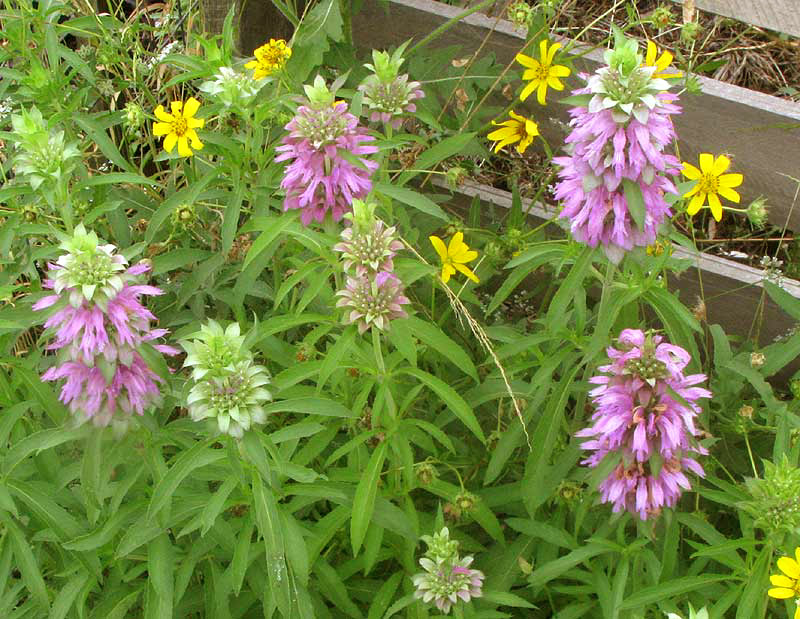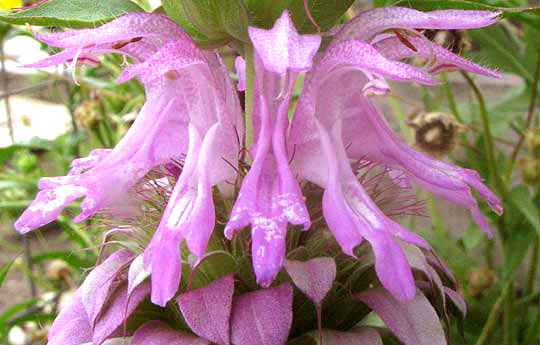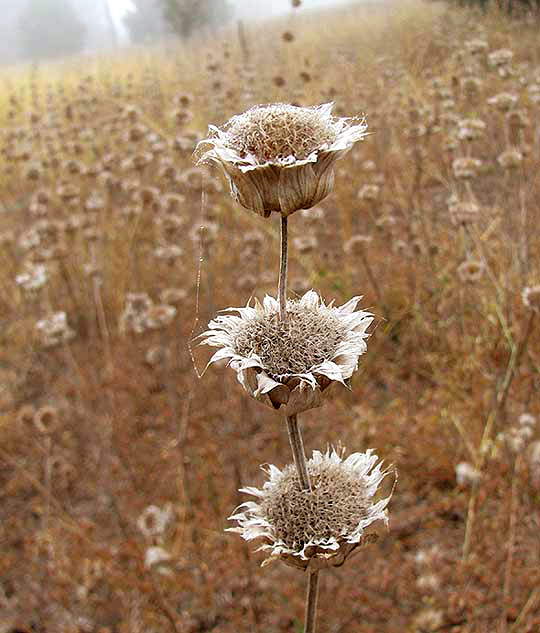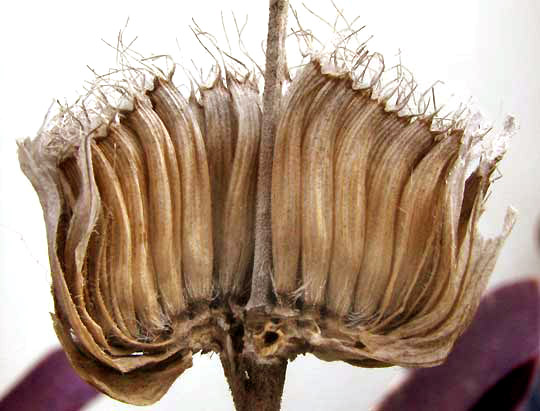Excerpts from Jim Conrad's
Naturalist Newsletter

from the June 2, 2013 Newsletter issued from the valley of the Dry Frio River in northern Uvalde County, southwestern Texas, on the southern border of the Edwards Plateau; elevation ~1750m (~5750 ft); N29.62°, W99.86°; USA
LEMON BEEBALM
Last December I showed you {see next section} a field of long-dead wildflower stalks that caught the eye because the stalks in a striking manner bore the remains of the previous summer's flower clusters in pagoda-like terminal spikes. The stalks were the remains of the Mint Family member Lemon Beebalm, Monarda citriodora, and I've been looking forward to their blossoming, expecting to see whole fields of tallish wildflowers with purplish flower clusters nodding in the wind. Well, the Lemon Beebalms are flowering now, sort of. The problem is that they're blooming only where I've been watering the compost heap and my garden. The field shown in the picture at the above link is nearly as brown and desolate as it was last December, in consequence of the drought. Still, it's a pleasure seeing the few Lemon Beebalms around my garden and compost heap. Above you can behold their purplish pagodas among yellow-flowered Engelmann's Daisies.
A close-up of a flower cluster showing that each flower possesses two stamens and a single slender, Y-tipped style arching beneath its down-curved upper lip appears below:

Lemon Beebalm's herbage certainly smells minty when crushed, and usually when any herb is so fragrant you find that traditionally it's been much used medicinally and/or as a food. I can find no references to this being the case with Lemon Beebalm, however. That may be because the species occurs over such a small area, being endemic to Texas, Louisiana, Oklahoma and a bit of Kansas.
Feeling a little guilty about snipping off leaves needed by this pretty wildflower, I made myself some mint tea. The tea was OK, with a slightly bitter taste, and not much improvement on mere hot water.
This beautiful mint, I think, is better left alone so the bees who seem to crave its nectar can take all the nectar they want, and we can see all the flowers we want.
from the December 16, 2012 Newsletter issued from the valley of the Dry Frio River in northern Uvalde County, southwestern Texas, on the southern border of the Edwards Plateau; elevation ~1750m (~5750 ft); N29.62°, W99.86°; USA
BEEBALM SKELETONS
Here and there in the Big Bluestem Grass prairie next to the cabin you see house-size patches of brown, dried-out, thickly occurring, bleached skeletons of a certain wildflower. On a recent foggy morning when the skeletons and the fog created a certain somber but pretty mood I photographed what's shown below:

These are three fruiting heads, each head consisting of many calyxes from long-vanished flowers packed closely within a bowl-like receptacle composed of modified leaves called bracts, with the plant's stem passing through the center of the lower heads. This looks very much like the basic flowering structure of members of the Composite or Sunflower Family, except that in that family you don't see stems passing through flower-head centers. If you're familiar with many wildflowers and garden herbs, probably you're guessing that this is a member of the Mint Family, which it is. Several kinds of mint have their stems passing through the center of flower clusters. A cross section of one of this plant's flower heads is shown below:

Even this looks like something from the Composite Family, but notice that there's no achene-type fruit below these slender, curvy calyxes, for ovaries in the Mint Family are superior -- arising above the calyx -- not inferior, arising below the calyx, as among the composites.
Usually it's hard to identify non-flowering mints to species level, but this one bore such distinctive fruiting heads, bracts beneath the flower clusters, and calyxes that I gave it a try. It keys out to be the Lemon Beebalm, MONARDA citriodora. Closely related, very similar species exist, but some field marks indicating that this is M. citriodora include:
Lemon Beebalm is endemic to Texas, Louisiana, Oklahoma and a bit of Kansas. Its purple/pink flowers are showy and when they appear in May and June our house-size colonies of them should present a bee-buzzed spectacle to behold.